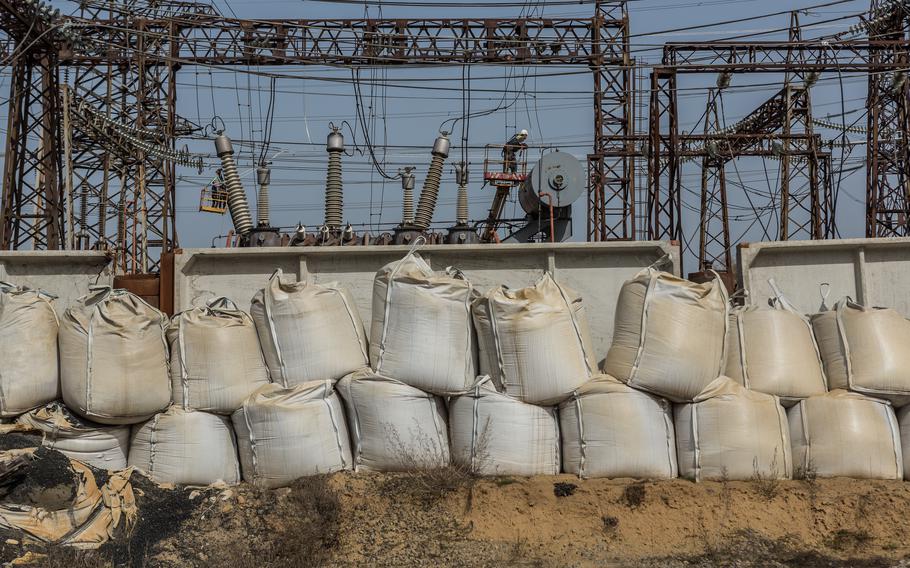
Damage to a Ukrainian thermal power plant by a Russian missile strike seen on April 2. (Oksana Parafeniuk for The Washington Post)
KYIV - While the rolling plains of Ukraine’s countryside are in full spring bloom, officials already fear what the distant winter will bring as a major energy crisis grips the country and power companies resort to phased blackouts to conserve supplies.
Russian territorial gains over the past months have been mirrored by successful missile barrages against Ukraine’s power plants, both abetted by faltering supplies of weapons and ammunition from the country’s foreign backers.
Ukraine’s energy companies are scrambling to repair the power stations damaged by Russian missiles before frigid temperatures set in - and avoid plunging the cities into the cold and dark when winter comes.
Since March, five waves of missile attacks have resulted in the “complete destruction” of the power stations from the DTEK private energy supplier, which produces 20 percent of the country’s electrical output, CEO Maksym Timchenko said in a Zoom briefing with journalists on Tuesday.
The last attack, on May 8, was particularly devastating, he said, because all of the missiles reached their targets, unimpeded by air defense, knocking out three more power stations.
“We need to get out of this cycle: destruction, repair, destruction - meaning we can lose everything if we don’t have proper air defense systems,” said Timchenko.
The missile campaign of the last weeks has caused $1 billion worth of damage to the energy infrastructure, Energy Minister German Galushchenko said at the beginning of the month on Ukrainian television.
Up until March, the electrical grid had actually escaped the pounding that Russian forces inflicted the previous year - which left the country on the edge of a total electrical collapse - thanks in part to an air defense system that intercepted a large number of missiles and drones.
But now, due largely to Western delays in arms deliveries, the air defenses have run low on ammunition and the Russian missiles are increasingly finding their targets, industry officials said.
Also, in contrast to the previous campaign against Ukraine’s energy sector, which focused primarily on destroying the electrical distribution grid, Russian forces are now directly targeting the country’s thermal and hydroelectric power plants.
This week, Ukraine’s state energy provider Ukrenergo announced plans for regular power cuts in every region of the country to overcome “a significant shortage of electricity.” This is taking place even though Ukraine is importing electricity from five neighboring countries.
Ukraine also experienced a cooler than usual spring, causing people to use heating units, which added to consumption, Yuriy Boiko, a member of Ukrenergo’s supervisory board, said. However, the cuts will continue into the summer as people then turn on their air conditioners.
At the moment, most of the conservation measures have fallen on businesses, which are restricting their consumption or switching to working at night and off-peak periods. But this threatens the economy, which has already significantly contracted because of the war.
“It is very important that our businesses can work, that we have someone to create GDP, strengthen the army, so that people have work,” Serhii Kovalenko, CEO of Yasno, a DTEK distribution subsidiary, wrote on Facebook on Wednesday. “It is wrong to transfer the entire deficit to businesses. If we want to win, we need to create parity between the population and business.”
Boiko said that consumption restrictions should be expected to last until September, by which time nuclear power stations - which provide half of the country’s electricity - will have ramped up production, while lower temperatures should reduce the energy demands.
But then winter will arrive.
Winter will be “undoubtedly difficult,” Boiko said - the only question is to what degree. Ukraine has lost some eight gigawatts of electricity production because of the strikes, he said - approaching half of what this country more than 30 million, the size of Texas, needs during peak periods.
“This [shortfall] can be significantly reduced,” but not to the extent that it could be halved or even eradicated, Boiko said. “That is, there will be a deficit in the electrical system even if the winter is warm.”
After Russia’s previous winter missile campaign, DTEK spent some $120 million on repairing equipment, almost all of which was “damaged and destroyed again” in the latest strikes, Timchenko said.
This time around the bill will be even higher because the power plants themselves were targeted rather than just the transmission infrastructure, and they will need to buy gas turbines, replacement generators and even equipment for entire control rooms.
Timchenko estimates that DTEK needs to spend some $350 million on equipment - including possibly used equipment from decommissioned European power plants. He hopes that a Ukraine Recovery Conference to be held in June in Berlin will contribute to their energy infrastructure needs.
If Ukraine’s energy companies accomplish all that they have set out to do, “we can go through next winter and avoid disaster,” he said. But for this, Ukraine needs Western support - including financial aid for purchases - and most of all air defense systems and ammunition.
“We are confident in what we are doing, we are confident that we can cope with this, we are confident that they will not destroy the power system, our company and Ukraine,” he said. “We know what to do. But we need help.”
Kostiantyn Khudov contributed to this report.